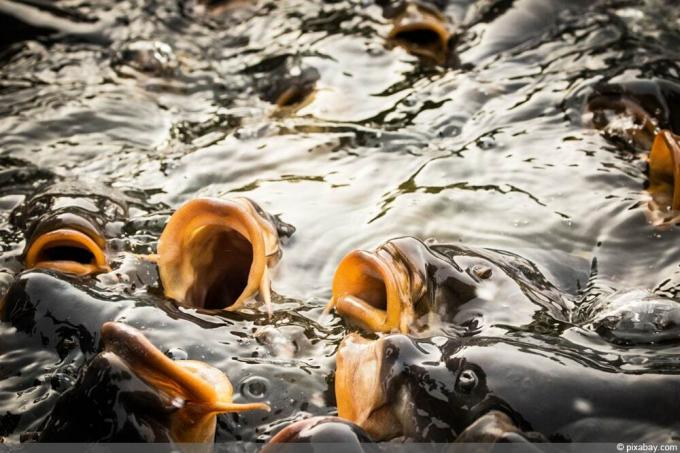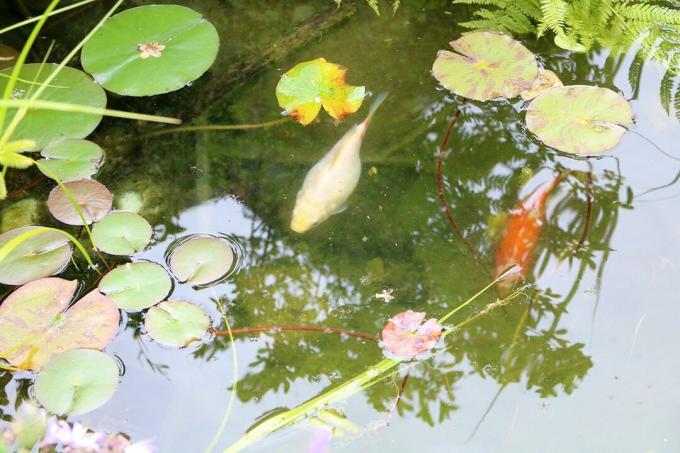

Table of contents
- A pile of water alone is not enough
- Is every pond size suitable for fish?
- The role of depth
- Allow new ponds to develop in peace
- The right timing is important
- How much water does a fish need?
- Determine the number of fish
Water is always a popular design element for small and large gardens. As soon as a pond is dug and filled, suitable plants follow around it. A green wet biotope is created. But that's not all: Many pond owners would like to go one step further and settle fish. But how many little fish are allowed to inhabit the wet realm at all? After all, space is limited.
A pile of water alone is not enough
Before calculating the optimal amount of fish, it must be mentioned that pure water alone is not a basis. The equipment of the water world provided must also be right. This includes a certain size of the pond, sufficient depth, a precisely fitting water flora and, if necessary, technical aids for cleaning and oxygen saturation of the water. Only a pond that has been prepared in this way can be used for successful fish keeping.
Is every pond size suitable for fish?
Of course, if you want to keep fish in your own pond, you do it first for your own pleasure. Watching them, following their swift movements, is exciting and relaxing at the same time. But the little swimmers should also have it good. Since a pond, in contrast to an aquarium, is an open system, many influences affect the biological balance.
- Theoretically it is possible to keep fish in every garden pond
- However, water quantities of 2000 liters or more are ideal
- with smaller amounts of water, the biological balance suffers
The conditions for keeping fish are not optimal in every pond. Technical aids and hard work can help to improve the quality of life for all pond inhabitants, whether animal or plant. With all the liveliness that prevails around and in the pond, it must not be overlooked that it is an "artificial" world created in a very small space.
The role of depth

Not only the sheer size of the pond is important for fish keeping. Depth is also important. The deeper the pond, the better it is for the fish that live in it. Some species are even dependent on a certain basic depth for a species-appropriate stay. The depth also prevents the water from freezing to the bottom in winter.
- at a depth of more than 80 cm, only the surface of the pond freezes
- Fish can hibernate in the mud on the bottom of the pond
If the pond is only shallow, it is better to avoid fish. Especially in summer, the water heats up quickly and the oxygen saturation drops.
A notice:
If the pond freezes over completely in winter, you may need another way of hibernating for your pond fish. For example, a sufficiently large aquarium.
Allow new ponds to develop in peace
A pond starts out as just a deep, bare hole in the ground that is filled with water. Such a “construction site” is not yet suitable for keeping fish. On the one hand, fish are noise-sensitive creatures, pending work on the pond would only stress them unnecessarily. Furthermore, most fish species need a harmonious flora right from the start. The installation of technical aids such as a pond pump or pond filter is sometimes a must.
- first the plant world must develop
- Plants are only established in the biotope after about 12 weeks
- they supply oxygen and offer opportunities for retreat
- install necessary technical aids
- only then is the pond ready for the fish
The right timing is important
As soon as the pond is in biological balance, the fish inhabitants can move in. Nevertheless, some patience may still be required. Because the actual entry into the new water world should take place at a suitable time.
- Spring is the ideal season
- the hibernation ends from a water temperature of 12 degrees Celsius
- there is enough acclimatization time until the next cold spell
- also applies to the expansion of an existing population
- Alternatively, early summer is also an option
- Do not add new fish to the pond from late summer
How much water does a fish need?
If the pond is well prepared and the optimal time has come, the only question that remains is: what types of fish and quantities should or should be used. may it be? Which of the suitable fish species are allowed to swim up and down in the home garden pond can be decided according to your own preferences. Well suited are, among others:
- some goldfish species
- Orfen for larger ponds, gold orfen are smaller
- Koi, with a pond depth of at least 1.80 m
- also: rotties, minnows, veiltails, shubunkin, etc.

When considering the quantity, it is important to remember that each fish needs sufficient space.
There are many guide values when calculating the fish stock, which can even differ greatly from each other. The most commonly circulated recommendations are:
- 5 liters of water per centimeter of fish
- or about 0.5 kg of fish per 1000 l
But these two formulas fall short because many fish are bought as young fish. They grow quickly and need more space. That should be factored in from the start.
- Experts recommend 60 liters per centimeter of body length
- less is enough for small fish
- for small redfin orfs, for example, approx. 200 liters per fish.
- Goldfish: no more than 5 pieces per 1000 l
- Golden orfe: water volume 500 to 1000 l per piece.
- Shubunkin: 300 to 500 liters per fish
- Species-appropriate koi keeping starts at 3000 liters per fish
A notice:
When planning, remember that it is not just the amount of fish that is brought in that counts. Goldfish, for example, reproduce happily and plentifully. The amount of fish can quickly exceed the available space and the natural food supply.
Determine the number of fish
The number of fish that can still feel comfortable in a spatially limited pond depends on various factors:
- the size of the pond
- the final size of the fish
- whether loners or schooling fish are used
The possible number of fish can be calculated approximately. However, since not all conditions can be predicted exactly, the following applies here: It is better to get fewer fish than too many.
- First determine the key data of your pond: width, length and depth.
- Calculate the amount of water using the formula: length x width x depth in meters. This value multiplied by 1000 gives the amount in liters.
- Alternatively, you can also read off the amount of water that has been let in.
- About 15% of the amount of water is from the decoration, gravel, etc. claimed. Approx. 1000 liters should be reserved for the plant world. The rest of the water is available for the fish.
- Find out about the preferences of each type of fish. For example, some may B. only live in swarms. A larger number of these would have to be taken into account during planning.
- Determine the fish species that suit you best.
- Check if the selected fish species can live side by side without harming each other.
- Calculate the amount by dividing the amount of water available by the amount needed per fish. Use the length/size of an adult fish as a starting point.
A notice:
Fish also have a significant impact on the pond ecosystem. They eat away plants, pollute the water etc. The more fish conquer the pond, the more labor-intensive the maintenance of the water oasis becomes.
 garden editorial
garden editorial I write about everything that interests me in my garden.
Find out more about animals in the garden pond

22 small pond fish | Fish for small pond
Only a small pond fits in small gardens. But Mother Nature has also created a few little fish for these mini ponds. To be more precise, even several interesting species, which are not inferior in beauty to the large specimens. But be amazed!

7 Fish Diseases | Help for pond fish
For many an animal lover, their fish mean everything. The concern is correspondingly great when the animals suddenly behave in a strange way or show external symptoms of one of the numerous pond fish diseases. This guide explains how the owner makes an exact diagnosis, what causes it and what to do in this case.

Overwintering pond mussels | 14 tips for pond mussels in winter
Pond mussels are practical animals for the garden pond, as they can filter and thus clean the water. Their main food source is algae. But what happens to the pond mussel in winter when the water surface freezes over? Here we reveal how overwintering is possible.

Orfe in the garden pond | 10 tips for keeping & propagation
The water has been filled in, the green planting is in place. Now a color contrast and movement in the garden pond are still missing. A swarm of gold orfs can provide both. Yellow-orange in colour, they are clearly circling in the water. When do you feel comfortable in it?

Frog in the pond: what do frogs eat in the garden pond?
Frogs in the pond are important beneficial insects because they devour numerous annoying pests. Frogs are good and patient hunters, able to ambush prey for a long time. The more diverse the pond is designed, the greater the food supply, which attracts different species.

Sturgeon in the garden pond | 10 tips for keeping in the pond
Would you like to enrich your pond with a real sturgeon? The desire for such a striking animal is easy to understand. Our tips on how to handle this living fossil will help you ensure that keeping is always successful.
